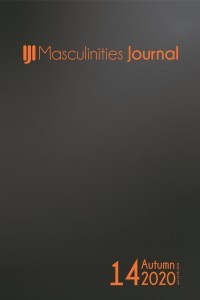Erkek Utancını Anlamak
Bu makale, erkek cinsiyetinin kültürel işleyişine yönelik daha iyi bir kavrayış geliştirme amacıyla, kadın utancından farklı olarak, bizzat erkeklerin kendileri için utanç verici kabul edilen bir duygu olarak gözüken erkek utancının paradokslarını açıklamayı hedefliyor. Bu çözümleme, utanç üzerine disiplinlerarası araştırmalara ve erkekliklerin kültürel temsillerine dayanarak, ilkin erkek utancının namus bağlamında yaorumlandığı ataerkil bağlamlarda yapmakta. Bu makale ayrıca, feminizmin doğrudan doğruya erkek bedenine uygulayıp erkek utancını yeniden konumlandırarak erkek rollerini yeniden tanımlaması vasıtasıyla, feminist söylemlerin eril hegemonya üzerinde yol açtığı rahatsızlıkların izlerini sürmektedir. Sonuçta ise bu yazı Steven McQueen’in Shame (2011) filmine odaklanarak, utanç postmodern erkeğe uygulandığında onu bir perişan haline getirdiğini ortaya koymak amacıyla utancı çağdaş kent bağlamında ele almakta. Erkeğin temelini çürütme ve onu iğdiş etme yetisine sahip bir duygu olarak utanç, erkek kimliğini korumak amacıyla maskelenmeli ve baskılanmalıdır
Anahtar Kelimeler:
erkeklik, utanç, namus, ataerkillik, hegemonik erkeklik, feminizm, erkek bedeni, çıplaklık, penis
Understanding Male Shame
In pursuit of a better understanding of the cultural functioning of male gender, this paper aims to explain the paradoxes of shame in men, which, as distinguished from female shame, appears to be an emotion interdisciplinary research on shame, and on masculinity in cultural representations, this analysis begins with an overview of the status of shame in patriarchal contexts, where male shame has been interpreted in terms of honour. Furthermore, the paper traces the disturbance to the masculine hegemony brought by feminist discourses, looking at the ways in which the redefinition of male roles by feminism repositions male shame, as now applying directly to the male body. Finally, based on the film by Steven McQueen Shame (2011), the paper discusses shame in the contemporary, urban context to reveal that shame in application to postmodern man becomes an abject. As an emotion that has the ability to undermine and emasculate men, shame, in particular when applied to the idea of masculinity based on performance, has to be masked and suppressed to protect male identity
Keywords:
masculinity, shame, honour, patriarchy, hegemonic masculinity, feminism, male body, nakedness, penis,
___
- Beynon, John. Masculinities and Culture. Buckingham: Open UniversityPress, 2002.
- Bordo, Susan. “Reading the Male Body”. The Male Body. Features, Destinies, Exposures. Ed. Laurence Goldstein. Michigan: The University of Michigan Press, 1994.
- Bouson, Brooks. Embodied Shame.Uncovering Female Shame in Contemporary Women's Writings. New York: Sunny Press, 2009.
- Butler, Judith. “Performative Acts and Gender Constitution”. Literary Theory: An Anthology. Ed. Julie Rivkin and Michael Ryan. Blackwell Publishing, 1998, 2004. p. 900-911.
- Clifton, James. “Gender and Shame in Masaccio’s Expulsion from the Garden of Eden”. Art History. Vol. 22, no. 5, December 1999. p. 637- 655.
- Connell, R.W. Masculinities. Cambridge: Polity Press (1995), second edition, 2008.
- Connor, Steven. „The Shame of Being a Man”. Textual Practice 15 (2001): p. 211-30.
- Delaney, Carol. “Seeds of Honor, Fields of Shame”. Honor and Shame and the Unity of the Mediterranean. Ed. David D. Gilmore. Washington DC: American Anthropological Association, 1987. p. 35-48.
- Freud, Sigmunt. New Introductory Lectures on Psychoanalysis (1933). Lecture 33: Femininity. Standard Edition, v. 22. p. 136-157.
- George, Roshin. “Salman Rushdie’s Shame: History and Fiction”. Mohit K.Ray, Rama Kundu Ed. Salman Rushdie: Critical Essays. Volume 1. New Delhi: Atlantic, 2006. p.129-152.
- Gilmore, D. David, Ed. Honor and Shame and the Unity of the Mediterranean. Washington DC: American Anthropological Association, 1987.
- --------- . Manhood in the Making: Cultural Concepts of Masculinity. New Haven, London: Yale University Press, 1990.
- Kołakowski, Leszek. “A Tale of Great Shame”. Tales from the Kingdom of Lailonia and the Key to Heaven. Trans. AgnieszkaKolakowska. Chicago, London: The University of Chicago Press, 1989. p. 84-89.
- Lea, Daniel and Berthold Schoene-Harwood. Posting the Male: Masculinities in Post-War and Contemporary British Literature. Amsterdam, Rodopi 2003.
- Lewis, Helen Block. Shame and Guilt in Neurosis. New York: International University Press, 1971.
- Lynd, Helen Merrell. On Shame and the Search for Identity. London: Routledge, 1958.
- McQueen, Steve. Shame, 2011.
- Munt, Sally. Queer Attachments: the Cultural Politics of Shame. Aldershot, Burlington, VT: Ashgate, 2008.
- Pajaczkowska, Claire and Ivan Ward, ed. Shame and Sexuality. Psychoanalysis and Visual Culture. London and New York: Routledge, 2008.
- Penner, James. Pinks, Pansies, and Punks. The Rhetoric of Masculinity in American Literary Culture. Bloomington and Indianapolis: Indiana University Press, 2011.
- Probyn, Elspeth. Blush. Faces of Shame. Minneapolis & London: University of Minnesota Press, 2005.
- Reader, Keith. The Abject Object: Avatars of the Phallus in Contemporary French Theory, Literature and Film. Amsterdam, New York: Rodopi, 2006.
- Rushdie, Salman. Shame. London: Pan, 1984, c1983.
- Sheets-Johnstone, Maxine. “Corporeal Archetypes and Power. Preliminary Clarifications and Considerations of Sex”. Hypatia. Vol.7, issue 3 (August 1992) p. 39-76.
- Tenenbaum, David. Issues of Shame and Guilt in the Modern Novel: Conrad, Ford, Greene, Kafka, Camus, Wilde, Proust, and Mann. Edwin Mellen Press Ltd, 2009.
- Wilde, Oscar. The Picture of Dorian Gray. London: Penguin Books, 1994. Wurmser, Leon. The Mask of Shame. Baltimore: The Johns Hopkins University Press, 1981.
- Williams, Bernard. Shame and Necessity. Berkeley and Los Angeles: University of California Press, (1993) 2008.
- Başlangıç: 2014
- Yayıncı: Eleştirel Erkeklik İncelemeleri İnisiyatifi
